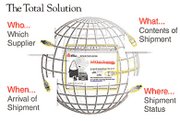A Promising Supply-Chain Solution
Plus, Web trends point toward monopolies; tips working without travel
Just when we thought B2B cyberspace was saturated—given that some ambitious Web-based supply-chain start-ups fell flat earlier this year—a new, very sophisticated start-up has been launched by Avery-Dennison. According to the company’s press release, it promises to allow users to “...see an accurate, accessible, reliable [supply-chain] solution that can benefit an array of trading partners in the retail and brand-owner supply chain, allowing them all to exchange and access information in one fast, convenient stop.”
This new service of Avery-Dennison’s Retail Information Services can be accessed at www.infochain.averydennison.com.
Products and services being offered include Web-based supply-chain management solutions, service bureaus, in-house imprinting systems and software, fully and partially preprinted tags, labels and label forms, sequential bar-code tags and labels, electronic article surveillance (EAS) tags and labels, fastener products and consulting services. Major markets include retail, apparel, softlines and hardgoods.
A compelling feature of the new site is a fast-paced Flash multimedia presentation that answers potential users’ questions by describing the functionality and capabilities of InfoChain Express. Segments include a flow chart that details how InfoChain Express works, a “Problems” segment, a “Solutions” segment and a summary of InfoChain Express’ capabilities. This is the clearest B2B service presentation we’ve seen yet.
Web Trends: Consolidating, Conquering?
It was first thought that Internet traffic would resist monopolization and consolidation because of the theoretically infinite number of possible Web sites. The opposite now appears to be the fact. The number of companies controlling 50 percent of user minutes online in the United States shrank from 11 to four over the past two years, according to a new report by Jupiter Media Metrix, which cites America Online, Yahoo!, Microsoft and Napster as the primary online portals. Moreover, the number of companies controlling 60 percent of all U.S. surfing time decreased from 110 to 14.
Lest any of us worry about the implications of this, it should be remembered that there was a similar fear in the 1950s, when the initial chaos of a new electronic medium called television all boiled down to just three networks.
Now, in the new millennium, cable and satellite offer more channels than you can shake a stick at. At the same time, according to TechTV, just over one-third of all American households have purchased something online, with apparel being the fifth most popular category (behind computers, travel, books and CDs). This represents an 18 percent increase over the same measure taken in September 1999. Total online consumer sales totaled $23.9 billion last year.
All of this is occurring while overall Web traffic and consumer purchasing online continues to grow dramatically. Our conclusion points to an online future where a few very large shopping portals will dominate consumer sales—at least for the time being.Doing Business Without Traveling
Conducting business these days has become feasible without the amount of travel it once took, courtesy of the Internet. There are virtual trade shows online. There’s plenty of coverage of trade shows too, many with excellent video clips of runways (a few are even streamed at you live).
B2B sites are available to facilitate contact and real transactions with vendors and customers worldwide. The California Apparel News Web site, www.apparelnews.net, is one place for both manufacturers and retailers to investigate what’s possible in terms of doing business through the Internet. Over 1,000 links in 33 categories (including “B2B,” “Trade Shows” and “Apparel Manufacturers”) await you and can be accessed just by clicking on the “Links” button. Some of the linked sites actually enable direct online business transactions, and the best ones offer compelling product presentations.






















